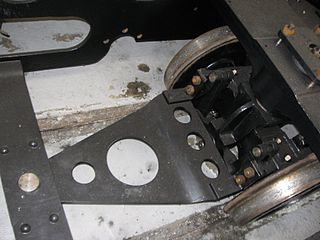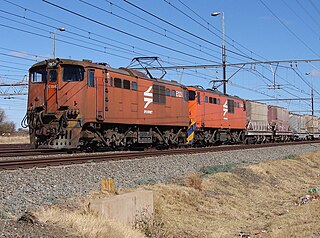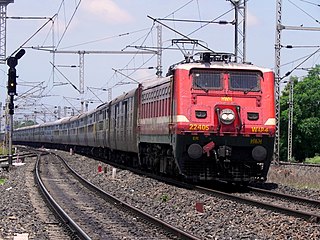
A bogie is a chassis or framework that carries a wheelset, attached to a vehicle—a modular subassembly of wheels and axles. Bogies take various forms in various modes of transport. A bogie may remain normally attached or be quickly detachable ; it may contain a suspension within it, or be solid and in turn be suspended ; it may be mounted on a swivel, as traditionally on a railway carriage or locomotive, additionally jointed and sprung, or held in place by other means.

Mason Bogie locomotives are a type of articulated steam locomotive suited for sharp curves and uneven track, once commonly used on narrow gauge railways in the United States of America. The design is a development of the Single Fairlie locomotive.

A Fairlie is a type of articulated steam locomotive that has the driving wheels on bogies. The locomotive may be double-ended or single ended. Fairlies are most associated with the Ffestiniog Railway in Wales.
The UIC classification of locomotive axle arrangements, sometimes known as German classification or German system, describes the wheel arrangement of locomotives, multiple units and trams. It is set out in the International Union of Railways (UIC) "Leaflet 650 – Standard designation of axle arrangement on locomotives and multiple-unit sets". It is used in much of the world. The United Kingdom uses the Whyte notation. The United States uses the simplified AAR wheel arrangement for modern locomotives.

An articulated locomotive is a steam locomotive with one or more engine units that can move independent of the main frame. Articulation allows the operation of locomotives that would otherwise be too large to negotiate a railroad's curves, whether mainlines or special lines with extreme curvature such as logging, industrial, or mountain railways.
A bogie is part of a railway car.

Co-Co is the wheel arrangement for diesel or electric locomotives with two six-wheeled bogies with all axles powered, with a separate traction motor per axle. The equivalent UIC classification (Europe) for this arrangement is Co′Co′ or C-C for AAR (USA).
B-B and Bo-Bo are the Association of American Railroads (AAR) and British classifications of wheel arrangement for railway locomotives with four axles in two individual bogies. They are equivalent to the B′B′ and Bo′Bo′ classifications in the UIC system. The arrangement of two, two-axled, bogies is a common wheel arrangement for modern electric and diesel locomotives.

Jacobs bogies are a type of rail vehicle bogie commonly found on articulated railcars and tramway vehicles.

Co-Bo or Co′Bo′ is a wheel arrangement in the UIC classification system for railway locomotives. It features two uncoupled bogies. The "Co" bogie has three driven axles and the "Bo" bogie has two.
Ian Bogie is a former footballer, and former manager of Gateshead and Stockport County. He spent two decades as a professional player, from 1985 up until 2001 he was playing in the English Football League, where he made 382 appearances.

A wheelset is the wheel–axle assembly of a railroad car. The frame assembly beneath each end of a car, railcar or locomotive that holds the wheelsets is called the bogie. Most North American freight cars have two bogies with two or three wheelsets, depending on the type of car; short freight cars generally have no bogies but instead have two wheelsets.

Bogie exchange is a system for operating railway wagons on two or more gauges to overcome difference in the track gauge. To perform a bogie exchange, a car is converted from one gauge to another by removing the bogies or trucks, and installing a new bogie with differently spaced wheels. It is generally limited to wagons and carriages, though the bogies on diesel locomotives can be exchanged if enough time is available.

A Krauss-Helmholtz bogie (Krauss-Helmholtz-Lenkgestell) is a mechanism used on steam locomotives and some electric locomotives to improve curve running.

A Bissell or Bissel truck is a single-axle bogie which pivots towards the centre of a steam locomotive to enable it to negotiate curves more easily. Invented in 1857 by Levi Bissell and usually then known as a pony truck, it is a very simple and common means of designing a carrying wheel.

Integral Coach Factory (ICF) coaches are conventional passenger coaches used on the majority of main-line trains in India. The design of the coach was developed by Integral Coach Factory, Perambur, Chennai, India in collaboration with the Swiss Car & Elevator Manufacturing Co, Schlieren, Switzerland in the 1950s. The design is also called the Schlieren design based on the location of the Swiss company. The 1st ICF coach had been flagged by then Prime Minister Jawaharlal Nehru on 2 October 1955. The last ICF coach was flagged off by senior technician Shri Bhaskar P. in the presence of Railway Board Chairman Ashwani Lohani on 19 January 2018. The Indian Railways intends to phase out ICF coaches and replace all of them with the newer LHB coaches and Train 18 or Train 20 coaches over a period of time, once the codal life of the existing ICF coaches end.

The South African Railways Class 6E1, Series 1 of 1969 was an electric locomotive.

The 1964–65 Illinois Fighting Illini men's basketball team represented the University of Illinois.

The Indian locomotive class WAP-6 is a class of 25 kV AC electric locomotives that was developed in the 1997 by Chittaranjan Locomotive Works for Indian Railways. The model name stands for broad gauge (W), AC Current (A), Passenger traffic (P), 6th generation (6) locomotive. They entered service in April 1996. A total of 17 WAP-6 units were built at CLW between 1995 and 1998.
A new wagon numbering system was adopted in Indian Railways in 2003. Wagons are allocated 11 digits, making it easy for identification and computerization of a wagon's information. The first two digits indicate Type of Wagon, the third and fourth digits indicate Owning Railway, the fifth and sixth digits indicate Year of Manufacture, the seventh through tenth digits indicate Individual Wagon Number, and the last digit is a Check digit.

















